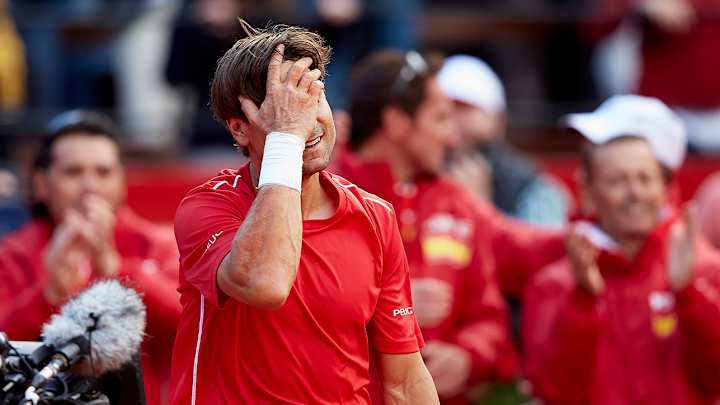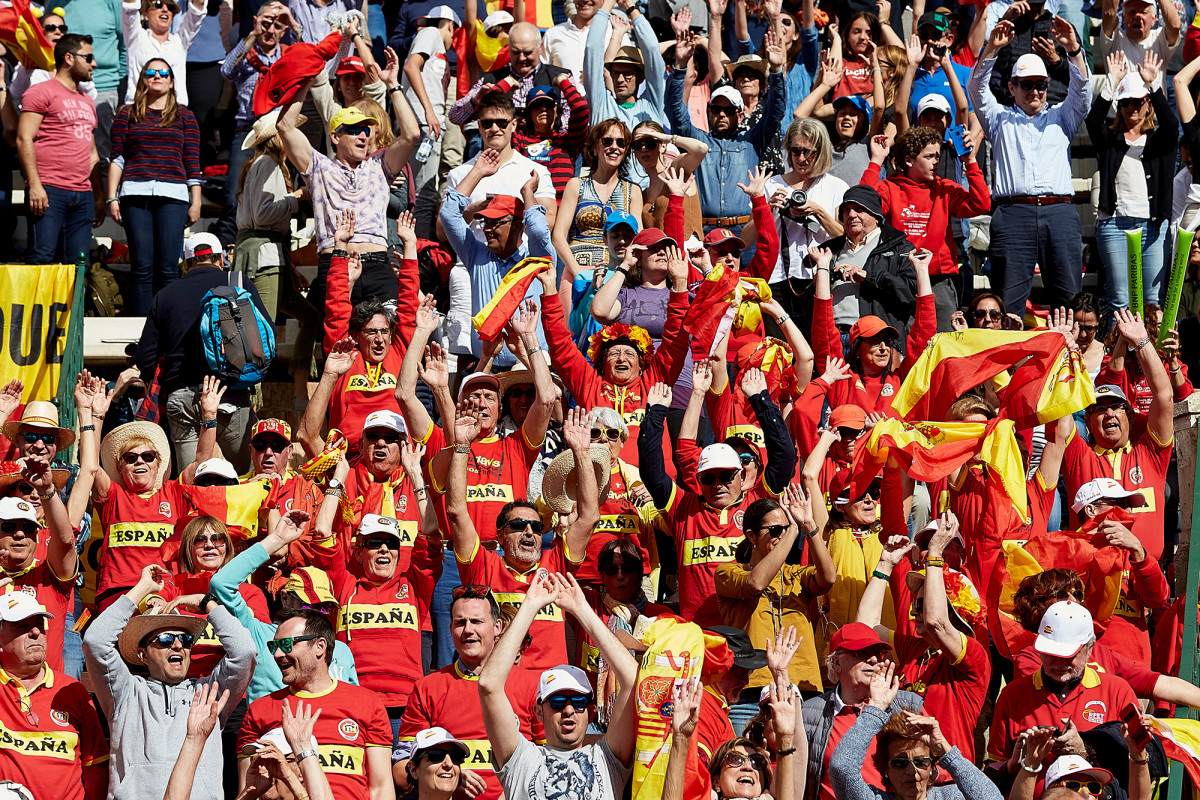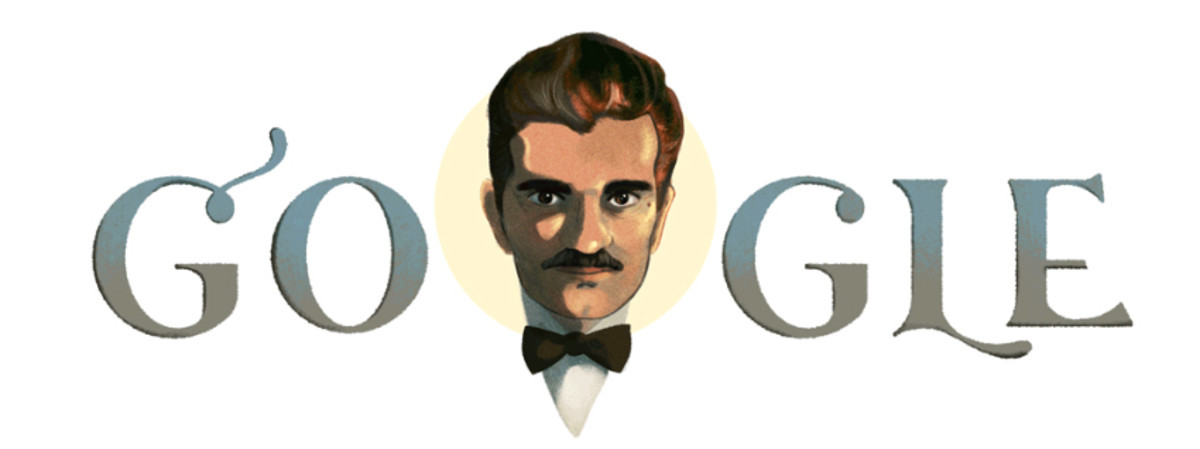Mailbag: Did David Ferrer’s Davis Cup Triumph Doom ITF Proposal for Revamp?

Hey everyone. Some quick housekeeping:
• Welcome a new tennis producer, Daniel Rapaport. From the Masters—he likes the subsport of golf—he takes over from the great Jamie Lisanti. Jamie will still help with podcasts.
• Godspeed to Casey Dellacqua—“Sports Good People,” as Frank Deford would say—who announced her retirement this week.
• The next podcast will feature Danielle Collins, a revelation of the spring, now up to No. 45 in the world.
• Last week’s guest: Chris Nashawaty, film critic for Entertainment Weekly and author of a new book on Caddyshack talking tennis movies.
Onward….
Mailbag
Have a question or comment for Jon? Email him at jon_wertheim@yahoo.com or tweet him @jon_wertheim.
David Ferrer didn’t just beat Philipp Kohlschreiber last weekend. He beat Dave Haggerty!
—Name withheld
• This came via text from a former player and it echoed several emails I received. The translation: last weekend’s Davis Cup played out against the backdrop of the ITF’s proposed remake, the end of conventional home-and-away ties through the year, in favor of a one-week extravaganza. When Ferrer won that gripping match in front of a partisan crowd, it reminded us of the beauty of Davis Cup. (And thwarted momentum for the “change agents,” whose proposal will be put to a vote in late summer.)
For what it’s worth, I’m told that if the vote were today, Haggerty and the ITF would not get the requisite support and that Lucas Pouille is the player most active in lobbying against the change.
A few of you asked for my thoughts and I would submit that there ought to be a compromise position. For reasons discussed to the point of cliché, the longtime model needs the equivalent of a software upgrade. For reasons empirical (drop-off in player participation, dwindling media coverage), practical (the clogged calendar) and visceral (loss of relevance) we need change.
Yet the proposed restructure has so many problematic elements. It doesn’t include women, which would be an obvious way to build support among federations, fans and sponsors. The week on the calendar is problematic, coming as it will at year’s end when players are exhausted and least likely to be motivated by money. At a time when Europe clearly represents the sport’s nerve center, holding the event in Asia makes little sense. The notion that armies of, say, Belgian tennis fans and Argentine supporters will converge on Singapore smudges the line between whimsical and delusional.
A common sense solution—a compromise—that better incorporates the old virtues and the new twists is the obvious next step. Tennis, alas, tends to resist common sense solutions….

Are you open to another perspective on the WTA’s on-court coaching? Point 1: As a female fan that plays USTA leagues, I like hearing the strategy. At Indian Wells, Caroline Dolehide’s coach told her to be the first to change direction when she was struggling in the third set against Halep, and she did it, and I saw immediately why it worked. We don’t get that kind of specificity from commentators, even former players. Point 2: Sometimes the players whine, but heck—I whine sometimes when I’m frustrated the court. I fight negative feelings. I relate to it. Point 3: While some observers see male coaches rescuing young women players, I don’t. I see an employee talking to an employer. If someone is predisposed to thing of women as weaker than men and their emotional displays as meltdowns, they’ll see it a different way. It’s in the eye of the beholder. I wish the players would look at their coaches more, and I concede that a lot of the interactions are whiny. I wish the women would use the opportunity a little differently. Point 4: Problem-solving alone in tennis isn’t sacred to me. Coaching is a typical part of sports. There are still plenty of moments during a match when a player has to right the ship alone. Closing argument here: “You never effing applaud! You sit there watching your flat-earth videos!"
—Megan F., Indianapolis
• Fair points. And I am always open to different perspectives, as well as the possibility that my views do not reflect majority views. Sincerely, thanks. (Though who among us doesn’t watch flat-earth videos?)
I wish that I saw savvy strategic discussions and brilliant tactical exchanges. Instead here’s what I see: a player in distress looking upset, confused and seeking succor. (It's seldom the winning players, awash in confidence, who call for the consultation.) A coach—usually a male—rushes onto the court. Breaching tennis’ cardinal virtues of self-sufficiency and autonomy, the coach begins by telling this emotional woman to calm down. He then begins an all-you-eat smorgasbord of clichés, often in a foreign language. Play your game. Focus. Worry about your side of the net. One point at a time. The player wears a look that says, “For this, I’m paying this yutz three grand a week plus incidentals?”
If there’s any entertainment value for the fan it’s of the unintentional, blooper variety. Don’t take my word for it. Tool around YouTube and look at the clips in rotation. It’s cursing and tantrums and otherwise dignified female athletes at their least flattering moments.
Meanwhile, at the concurrent men’s matches, the players aren’t permitted these interactions. (Message: this is a special accommodation for the women, who must rely on others.) And at the majors, coaching is also prohibited. (Message: this coaching gimmick underscores that this is a run-of-the-mill tournament and not serious event.)
If we're going to have mid-match, on-court coaching—bastardization of tennis that it is—can we at least agree that it could benefit from a) the ATP adopting the same policy and b) the WTA prevailing on the majors to get on board?
Have you seen Borg vs. McEnroe and 2) have you heard Mac comment on it yet?
—@jjcruiser
• We talk about this on the most recent podcast. I saw a screener the other day and thought the movie was quite strong, far better than I had expected. It's scripted so the filmmakers take artistic liberties. But the performances are winning, the characters are strong and the tennis scenes—while in need of editing—are not excruciating.
Not for nothing is it called Borg vs. McEnroe; and not vice versa. A Scandinavian film, it’s focused far more on Borg and his inner circuitry and torment than it is McEnroe. The thesis isn’t particularly revolutionary. That is, Borg, the alleged Iceman, wore a mask of cool and a smoldering inferno lay underneath it all. McEnroe, the alleged hothead, was more tempered than his caricature, more complex than the “tortured genius” shorthand.
Here’s a trailer. McEnroe is not a fan. He had this to say during Laver Cup last fall: “Unfortunately, even though I wished it was a good movie, I don't think it is a good movie, I'm sad to say. A lot of it is not accurate. I mean, I don't know why they couldn't make it accurate. They made up some stuff. There is plenty of stuff—if they wanted to make me look like a jerk at times, they could have come up with something far better than they came up with, in my humble estimation.”
I'm writing in response to two issues raised in the Mailbag today. First, I've seen several posts on SI and other sites that refer to Alexander Zverev as "Sasha." I may be wrong here, but I'm pretty sure that the correct spelling of his nickname is "Sascha." It's a little thing, but I think, all things being equal, it's good to spell the players names properly.
My more pressing observation is in response to Mailbag Reader Fernando's letter about Delpo and Federer (and others?) skipping the clay court season. Personally, I'd love to see Roger play at least a few clay events, because I think this is his last best chance (how many times have we said that about Federer?) to go deep in, if not win, the French Open. But it wasn't too long ago that players routinely skipped events on surfaces they didn't favor. The so-called "Spanish Armada" of the late ‘90s, including Carlos Moya, Alex Corretja and two-time French Open champ Sergi Bruguera, tore it up during the clay court season and then went silent during the grass season and rarely bothered to show up for Wimbledon. Over the course of his 14-year career, Gustavo Kuerten only made five appearances at the All England Lawn & Tennis Club. It wasn't until the mid-2000s, with the combination of slower courts and improvements in racket technology, that we started seeing more players make that transition from clay to grass. I'd be willing to be that if he'd started his career 10 years earlier, Rafael Nadal wouldn't have played—let alone won—at Wimbledon. So at this point in his career, I can't be mad at Roger for skipping a surface that puts more wear and tear on his body.
As always, I enjoy your insight!
—Judy A., Los Angeles, Calif.
• On the correct spelling of Zverev’s nickname, let’s defer to the ATP media guide. “Sascha,” it is.
I would take issue with your point about Nadal. Between his competitive fury, his love of a challenge and his criminally underrated net skills, I suspect Nadal would always have entered Wimbledon. But your larger point is a good one: two decades ago, players in the prime of their careers—not 36-year-olds making career-prolonging strategic decisions—were skipping Slams. We’ve come a long way.
I hope I made this clear, but Federer’s decision to skip the clay—while perhaps not pleasing to fans—can't really be attacked. He’s closer to 40 than 30. He’s still trying to maximize his time and chances of winning majors. He knows that his chances on grass are better than his chances on clay. He’s just being practical, really.
Hey Jon. I was watching Zverev’s match and saw how challenges on match points can obviously diminish the player’s excitement when they have won. Why doesn’t the ATP run the challenge on the ball regardless of whether the other player requests for one or not.
—Vivek
• I’m not sure what match this pertains to but this comes up a lot, most notably the 2017 Australian Open final.
I’m not sure what we can do here. The trailing player has nothing to lose by issuing a challenge. In fact, I’m surprised we don’t see this more often. Yes, it disrupts of the drama and the visuals of victory. But seems a small price to play for (relative) certainty.
There is a context for Martina Navratilova's complaint that John McEnroe earns 10 times what she does. The issue exploded at the BBC in the past few months. A few months ago, an editor in BBC's China office found out about pay disparity, wrote an open letter and resigned. Take a look at this. You can dig further within the BBC site.
The New York Times covered it. Here's one article. Remember there is a history at Wimbledon—a different entity, I grant you—when the women earned less than the men. One senior official at the AELTC said that if the club paid women equally, there would be none left to pay for the flowers! Sorry, I cannot back that up, and do not remember the man's name or the approximate date when he made the statement. He was pretty cheeky given that his sovereign is a woman. Tracy Austin also calls matches for the BBC at Wimbledon. One can only wonder how well she is paid. How about Tim Henman?
—Margaret
• “If we paid the women more, we wouldn’t have so much to spend on petunias.”
To me the backstory is less Wimbledon than it is the BBC. When you’re a public entity, you owe aforementioned public some transparency in your decision-making.
Re: Djokovic you wrote: “His fans have not abandoned him. But something sure has.” Yes. It’s his muscle mass. Granted he has never had the oak tree quads of Nadal nor the photoshopped biceps of Andy Roddick, but I have been shocked and quite frankly a little concerned about the rail-thin physique he has been modeling this season so far. I wouldn’t dare speculate on the reasons for his weight loss (and I doubt you would either) but I can’t help but believe his diminished muscle mass contributes to his ongoing struggles.
—Eric Maitland, San Diego, Calif.
• For those who missed the reference, were this to have taken place a few years later, “Roddick’s biceps” would have gotten its own twitter handle.
Mental versus physical is a false dichotomy. Brain and body work in concert with each other, both for good and for ill. But to me, Djokovic’s woes go to something far deeper than a few pounds of bulk or an elbow injury that might exact a price on his serve. There’s something uncomfortably voyeuristic, but this inner battle—distilled to its essence: to solve his own riddle—might be the most compelling plotline in tennis today.
How odd for Dimitrov, at 6’3”, to find himself in the short half of the top 10.
—Chris Brown
• Right. Yet look at the next wave. Shapovalov, Tiafoe, Coric, even Chung…. doesn't exactly recall an NBA front line. It’s funny: we’ve spoken since the 1990s about men’s tennis devolving into Robo-tennis and the 6’6” behemoths, scrubbed of nuance and artistry, blasting away. Still hasn’t happened.
Shots, Miscellany
• Go home, everyone. This is the best on-court interview of 2018.
Naomi Osaka gives the best on court interviews ever. #VolvoCarOpen pic.twitter.com/qAxVS6lzLh
— #BLM! Tennis Nerd Podcast (@TennisNerdPod) April 5, 2018
• Federeresque, the new coffee table book from Mark Hodgkinson and Antoine Couvercelle, comes out April 20. The first 500 orders through Payot stores to receive a free 'Federesque' T-shirt.
• The Film Society of Lincoln Center announces the fifth edition of Art of the Real, an essential showcase for the most vital and innovative voices in nonfiction and hybrid filmmaking, April 26–May 6. The 2018 lineup features a host of brilliant new works and exciting artist spotlights, including one world premiere, eight North American premieres, and seven U.S. premieres, with many of the filmmakers in person. The Opening Night selection is the North American premiere of Julien Faraut’s John McEnroe: In the Realm of Perfection, an essayistic found-footage ode to the capricious tennis legend. Tickets go on sale April 13.
• Press releasing: The Western & Southern Open today announced that Chief Executive Officer Elaine Bruening will retire effective April 13, 2018.Starting as a volunteer in 1976, Bruening assumed a full-time role with the event in 1988 after a career at Procter & Gamble. She worked alongside longtime Tournament Director Paul Flory for more than 35 years and was officially elevated to CEO in 2011. At the time of her retirement, Bruening is the only female CEO of a Master 1000 level event on the ATP World Tour. Bruening also was the first female to be appointed to the men’s tennis ATP Media Finance Committee, a role she will relinquish upon retirement.
• The USTA today announced that it will host the second annual USTA All-American College Combine for American juniors June 18-21 at the USTA National Campus at Lake Nona in Orlando, with an expanded, level-based singles tournament and reduced-cost registration.
• Kellen Becoats on Prim Siripipat.
• Congrats, David Law, whose Tennis Podcast just uploaded its 400th episode. They post Monday throughout the year and then daily during the Slams and at Queen’s. Subscribe on iTunes: The Tennis Podcast by David Law and Catherine Whitaker on Apple Podcasts.
• Cam Bennett of Canberra has LLS: Roger Federer and the Omar Sharif Google Doodle

• On the heels of the biggest victory in his illustrious 11-year professional career, winning his first ATP Masters 1000 title, John Isner is not only gearing up for Davis Cup and the rigorous clay court season, but something that hits a little closer to home.
The top-ranked American tennis star and world No. 9 singles player has teamed up with Give2Gain, a sports and entertainment-focused online giving platform, to launch a global fundraising campaign to support his charity, The UNC Lineberger Comprehensive Cancer Center. The 70-day campaign will help raise funds and awareness for the only public comprehensive cancer center serving the state of North Carolina by raffling off a once-in-a-lifetime trip to Wimbledon. The center is very important to Isner as it is where his mother, Karen, was treated successfully in her battle with colon cancer. The campaign concludes on June 10, 2018, at which time a grand prize winner will be randomly chosen from the entries to join Isner in London, England for this year’s 2018 Championships, Wimbledon.
